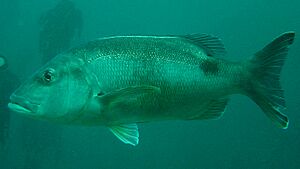Red steenbras facts for kids
Quick facts for kids Red steenbras |
|
|---|---|
 |
|
| Conservation status | |
| Scientific classification | |
| Synonyms | |
|
The red steenbras (Petrus rupestris) is a special kind of fish. It belongs to the Sparidae family, which includes many types of sea bream. This fish is the only known species in its group called Petrus. You can only find the red steenbras in South Africa. Sadly, there aren't as many of these fish left because of too much fishing. Because of this, it is now listed as an Endangered animal.
About Its Name
The red steenbras got its scientific name, Dentex rupestris, in 1830. A French scientist named Achille Valenciennes first described it. Later, in 1938, a South African scientist named James Leonard Brierley Smith gave it the new name Petrus.
The name Petrus comes from the Greek word petra, which means "rock". This is because the red steenbras loves to live among rocks. Its other name, rupestris, also means "dweller in rocks". Both names tell us about its rocky home.
What It Looks Like
The red steenbras has scales on its head that go past its eyes. Its body is long and a bit flat. It has a dorsal fin on its back with 10 stiff spines and 10 or 11 soft rays. Its anal fin on its belly has 3 spines and 8 soft rays.
In the front of its mouth, the red steenbras has 4 strong, pointy teeth on its upper jaw. It has 4 to 6 similar teeth on its lower jaw. Behind these, it has a band of smaller, fine teeth.
This fish is usually reddish, bronze, or golden-yellow. Young fish might have a dark spot near their dorsal fin. The red steenbras is the largest fish in its family. It can grow up to 200 centimeters (about 6.5 feet) long. Most commonly, they are around 100 centimeters (about 3.3 feet) long. The heaviest one ever recorded weighed about 80 kilograms (about 176 pounds).
Where It Lives
The red steenbras lives only in South Africa. You can find it from Table Bay in the Western Cape to St Lucia, KwaZulu-Natal. It lives in waters from 5 to 150 meters (about 16 to 492 feet) deep.
Adult red steenbras prefer deeper rocky reefs, usually below 50 meters (about 164 feet). Younger fish live in shallower reefs.
Life and Habits
The red steenbras is a carnivore, meaning it eats other animals. It enjoys eating octopuses, crabs, and other fish. One of its favorite meals is the fish called Spondyliosoma emarginatum.
This fish matures slowly. Both males and females become ready to reproduce around 7.2 years old. At this age, they are usually about 63 centimeters (about 25 inches) long.
The red steenbras spawns, or lays its eggs, from August to October. They gather in groups to spawn. This usually happens in the sea between East London and southern KwaZulu-Natal. It also occurs on the offshore Agulhas Bank. Females have many eggs, which means they can have a lot of babies.
Fishing and Protection
The red steenbras used to be a very popular fish for both fun and commercial fishing in South Africa. However, in 2012, a ban was put in place. This means people are not allowed to fish for them anymore.
This fish lives a long time and grows slowly. It also matures late in life. These traits make it very easy to overfish. Once too many are caught, it's very hard for their numbers to grow back.
Even with the ban, illegal fishing is still a big problem. This is especially true when they gather to spawn. This illegal fishing stops the population from recovering. Because the red steenbras is long-lived, slow-growing, and has been overfished, its numbers are still low. The International Union for Conservation of Nature has listed it as Endangered. They are even close to being called "Critically Endangered." Scientists are working to understand how many are left and if the fishing ban is helping.


